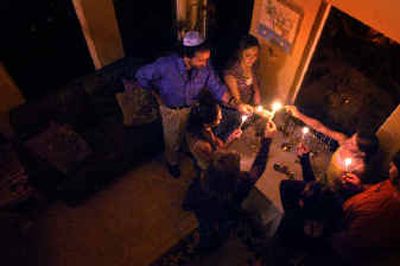Hanukkah traditions

In the crowded entryway of his Liberty Lake home, Lloyd Halpern gathers his wife and four daughters after sundown each evening of Hanukkah to light the candles of a half-dozen menorahs and sing a song honoring their Jewish history and hope for freedom. The celebration brings them together with a depth of meaning that just a few years ago had eluded the family. “We are all Jewish in this family,” Halpern says, embracing a truth that wasn’t always the case.
Hanukkah began at sundown Dec. 7 and lasted eight days. It is a celebration of religious freedom, the power of a spirited minority to prevail over a tyrannical majority. More than 2,100 years ago, Jews in Judea fought the Greek kings for the right to pray and study the Torah. It is said the Greeks went as far as placing an idol of Zeus in the Jewish Holy Temple in Jerusalem.
The Jews assembled a militia, named the Maccabees after the four brothers who founded it, to fight oppression and Greek paganism. After three years, the minority Maccabees won their right to worship, retaking the Holy Temple in Jerusalem. The day they purified the temple and rededicated it, the 25th day of the month of Kislev, 164 years before Christ’s existence, marks the beginning of Hanukkah.
The Greco-Syrians, who defiled the temple, had corrupted the oil used to light the temple’s menorah. One vat of oil remained, enough to light the menorah for only one day, but amazingly, the menorah burned for eight days, just long enough for more oil to be purified. The eight days of Hanukkah represent the miracle of the menorah and the single vat of oil.
Hanukkah isn’t Judaism’s most important holiday, but it is the most recognized by the non-Jewish community because of its proximity to Christmas.
Up until about five years ago, the Halperns celebrated Christmas and Hanukkah. Unlike Lloyd, Carmen wasn’t Jewish by birth. In fact, neither were their four daughters because Judaism recognizes the children of mixed marriage as Jewish only if the mother is a Jew.
Lloyd Halpern would get out the menorah he’d had since college, along with the one he and Carmen received from Lloyd’s mother at the beginning of their marriage. A few weeks later, the Halperns would put up a Christmas tree.
Christmas was more of a secular celebration for the Halperns. Jewish families who decorate a tree in December jokingly refer to the lighted pine as a Hanukkah bush. The kids also dyed eggs at Easter and celebrated pretty much all the holidays.
But it was clear to Lloyd and Carmen that their children weren’t grasping the deeper meaning of the holidays. Rather, the traditions of both cultures were being grazed upon like chocolates in a Whitman Sampler.
Carmen, who had been leaning toward becoming Jewish, decided it was time to begin the nine months of required study. The conversion wasn’t easy. Judaism doesn’t open its doors to converts the way evangelicals do. Tradition required the Halperns’ rabbi to harshly turn Carmen away three times before allowing her to be considered for acceptance. The children also had to convert.
It was around the time of Carmen’s conversion that the rabbi suggested it was less than sincere to keep observing non-Jewish holidays. The Halperns scrapped the Hanukkah bush, which socially wasn’t easy for the children who were inundated in Christmas culture at school.
To this day, the Halpern children watch from the sidelines as Christmas unfolds in their classrooms, at the malls and in the choirs in which they sing. At Central Valley High School, Kelsi Halpern, 17, is performing a full list of Christmas standards and one Hanukkah song.
But Kelsi said the family’s commitment to Judaism proved invaluable. It rooted them in a culture rich in history and principle. There’s a picture in her family scrapbook of young Kelsi lighting her menorah with her father standing in the background. Kelsi said she looks upon that moment as a turning point for her family and herself, a sentiment shared by her older sister Crystal.
“It made me feel like I belonged to something,” Crystal said of her conversion to Judaism, “Like we belonged to something bigger.”
In the east window of the family’s Liberty Lake home, the thin blue candles from a half dozen menorahs are rapidly burning down. The heated air from the display can be felt from the top of the stairway descending from the home’s second floor to its entryway. In the window, the reflection of the flames resembles dozens of stars in a glassy night sky.
In previous years, the Halperns would place their candles elsewhere in the house, Carmen said, but they now observe the tradition of placing the display in a window for the world to see. After all, Hanukkah is a celebration about keeping Judaism’s flame burning, about the freedom to be Jewish.
Now that the Halperns’ own spirituality has been kindled, they lock it away from no one.